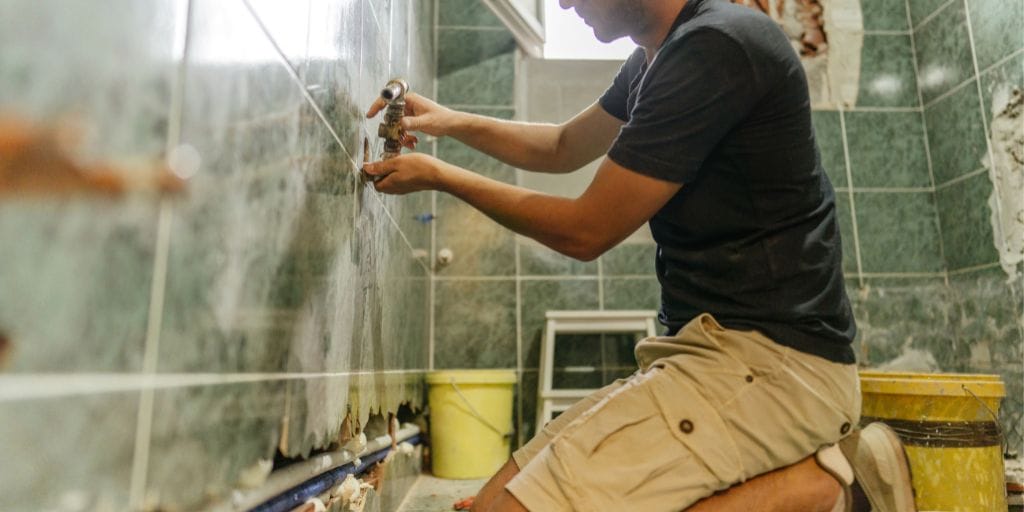Renovating a bathroom can feel overwhelming. After all there are a million little decisions to make, and it’s one of the most-used spaces in any home. The chances are you’ve already got a few questions in the back of your mind. Maybe you’ve seen a few things online, spoken to a tradesperson, or just stood in your bathroom wondering where to even begin.
We’ve found that many people ask the same handful of things. Whether it’s about removing the bath, dealing with grout, or finding storage that actually works, these are the conversations that come up again and again. So we’ve pulled together the most common questions we hear, along with our honest answers based on what really works in everyday homes.
You don’t need to follow trends or aim for a showroom-perfect space. A good bathroom should suit you, how you live now, and how that might change in the next few years. That’s what this guide is here to help with!
“Should I remove my bathtub for a walk-in shower?”
This is one of the first decisions people make, and it often comes with a bit of back and forth.
Walk-in showers are great. They’re easy to use, easy to clean, and they can open up the room, especially in smaller bathrooms. If you’re thinking long-term or planning to stay in the house as you get older, a shower with level access is a smart choice.
But baths still have their place. If you’ve got young children (or plan to), a bath is practical. And from a resale point of view, having at least one bath in the house is usually seen as a plus for buyers.
So what’s the best option? Well, think about what you actually use now. If your bath hasn’t been used in years, it’s probably not worth holding onto. But if you enjoy a soak now and then, or want to keep it for family use, you’ll want to think about including one in your new space.
For more information on baths vs showers, you can take a look at our guide here.
“What’s the best way to make the bathroom easier to clean?”
Cleaning is a big one as no one particularly enjoys spending hours scrubbing their bathroom! People often say they’re happy to spend a bit more if it means they won’t be constantly scrubbing tiles or wiping water spots off every surface.
Our biggest tip is to reduce grout wherever you can. Grout is where mould and grime love to settle in. Using large-format tiles or wall panels makes a huge difference. Wall panels in particular are great in showers, they give a clean, seamless finish, and they’re really easy to wipe down. (We’ve got a separate blog about wall panels if you want to take a closer look.)
Other simple ways to reduce maintenance include:
- Go for smooth, simple basins. Deep bowls and raised basins look great but can be fiddly to clean.
- Choose vanities and toilets that are wall-hung. Being able to mop underneath makes things so much easier.
- Avoid black tapware unless you’re happy to clean regularly. It shows up water marks and soap scum more than most other finishes.
- On a similar note, think about what materials you’re using in general as some come with much more overall maintenance than others.
“How can I maximise storage in a small space?”
Storage is something nearly everyone wants more of, especially in older bathrooms where there was never much to begin with. The first thing to do is think about what actually lives in your bathroom. Towels? Skincare? Hair dryers? Cleaning supplies? Once you’ve got a rough list, you can work out how much storage you actually need and where it needs to be.
Some of the best options:
- Drawers instead of cupboards in your vanity. You’ll be surprised how much easier they are to use day to day.
- Mirrored shaving cabinets above the basin. They’re great for everyday items you want easy access to, but don’t want to have cluttering your surfaces.
- Shower niches built into the wall keep bottles off the floor and look tidy.
- Open shelves above the toilet or behind the door for things you don’t use every day.
It’s also worth thinking about who uses the space. For example, if you’ve got kids, or someone with mobility needs, the layout and access matters just as much as the amount of storage.
For more tips on bathroom storage and how to make it work for your space, check out our bathroom storage guide.
“Should I be planning ahead for ageing in place?”
This is becoming more common, and honestly, it’s worth thinking about even if it feels a little early. A few small design choices now can make a big difference later:
- Walk-in showers with no step
- Grab rails that look like towel bars (they don’t all have to look clinical)
- Comfort-height toilets, about 80mm taller, which makes them easier to use
- Non-slip flooring, especially in wet zones
These simple additions help ensure your bathroom is safe and accessible, whilst ensuring it doesn’t feel cold or medical. If you’re planning to design your bathroom with older individuals or ageing in mind, we’ve put together a full blog on the topic to help guide you through important considerations, from layout and lighting to fixtures and finishes. You can read it here!
Final thoughts
Renovating a bathroom comes with a lot of decisions, but if you start by thinking about how you live (and what will make the space work better for you) the rest tends to fall into place. If you’re still unsure, we’re always happy to answer your questions and help you avoid the common mistakes.
Come have a chat with our friendly team. We have decades of experience helping our customers create their dream bathrooms.

